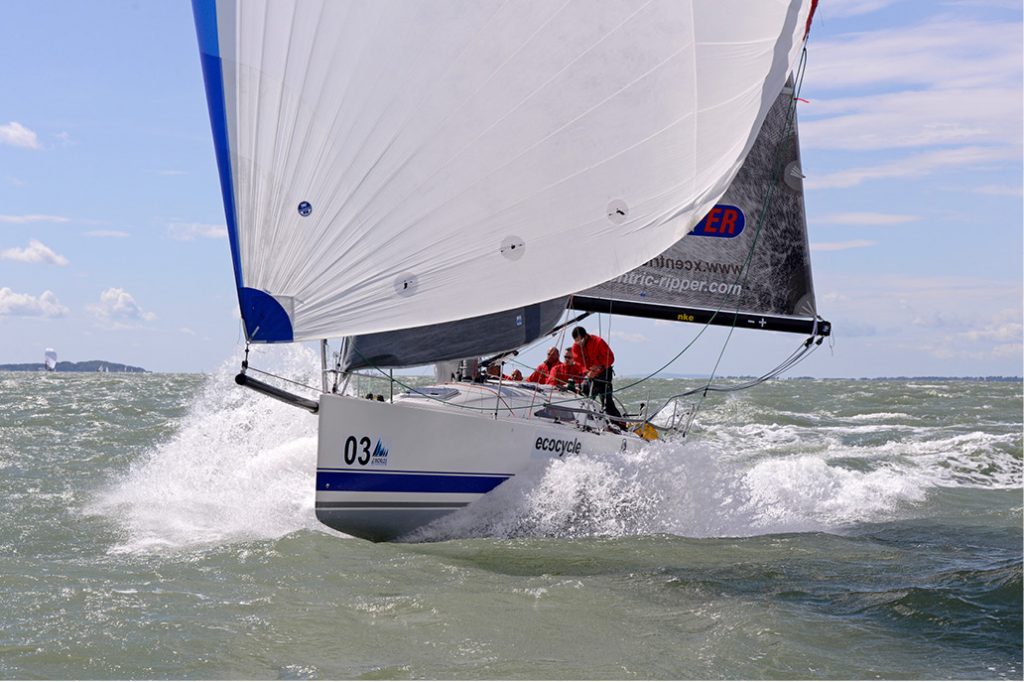The middle of the racecourse is one of those “love it or hate it” places. Some sailors are always trying to make the middle work, while others seldom go there. In a big fleet, the central part of the beat has unique advantages and disadvantages. No matter how you feel about the middle in smaller fleets, you might want to reconsider your opinion in bigger fleets, for the following reasons.
The case for the middle
In a large fleet, staying near the middle of the windward leg is good for at least two reasons. First, it keeps you away from the laylines, which are almost always crowded in big fleets – if you reach a layline too early, you will either have to sail in bad air for a long time or overstand and lose a lot of distance.
Second, playing the middle of the beat helps you avoid the disas- ter of being on the wrong side of the beat. Long windward legs mean the boats get far apart; even a small windshift will produce huge gains and losses. When you’re not sure what the wind will do, stay near the middle to avoid huge losses and losing touch with the leaders.
There are certain conditions when your odds of success in the middle are highest. These include times when: 1) you are sailing in strong breeze; 2) you are fast and near the front of the fleet (i.e. when there aren’t many boats ahead of you to give you bad air); 3) the fleet is spread out; or 4) the wind is oscillating (because once you reach a layline you can no longer play the shifts).

Get away from the crowd. On a run in a big fleet there are usually packs of boats everywhere. It almost seems that boats gravitate toward each other, but this doesn’t make sense. A boat sailing by itself will almost always go faster than any boat sailing in a crowd. Courtesy of J Boats
In these cases, follow the basic rule of thumb that says, “Sail the longer tack first.” Look for lanes of clear air that lead you back toward the middle and away from the laylines. This will minimize strategic and tactical risk.
The case against the middle
There are also several good reasons to avoid the middle of the beat in a big fleet. For one thing, most of the boats are there, so you’ll find a lot of bad air and disturbed water. Unless you have a very good start and fast speed, it can be difficult to get a lane of clear air, and you may end up doing way too much tacking.
A second reason to avoid the middle is that there is often less breeze there than on the sides of the fleet (see below). The wind tends to treat the fleet as one large obsta- cle, so much of it flows around and ver all the sails. This is especially true in light air, when the wind has less energy to push through the fleet. In this condition, boats in the middle often lose to boats that play both sides of the course!
Every beat is different
It’s hard to make a rule of thumb about what to do on beats in big fleets because the relevant mix of variables is always unique and changing. For example, how strong is the wind, and how good is your boatspeed? Where are you in the fleet, what is the windshift pattern, and where are all the other boats?
If we want to generalize, we could say that the middle of the windward leg gets better when the wind is stronger and oscillating, and when you have good boatspeed with few competitors around you.
On the other hand, you want to avoid the middle when the wind is lighter and when it is shifting per- sistently, or when you are slow or there are lots of boats nearby. ■
This article originally appeared in David Dellenbaugh’s Speed & Smarts, The newsletter of how-to tips for racing sailors. If you want to sail faster and smarter, log onto SpeedandSmarts.com.
A resident of Easton, CT, Dellenbaugh was tactician and starting helmsman for America3’s successful defense of the America’s Cup in 1992. He’s a Lightning World Champion, two-time Congressional Cup winner, seven-time Thistle National Champion, two-time winner of the Canada’s Cup, three-time Prince of Wales U.S. Match Racing Champion, and a winner of the U.S. Team Racing Championships for the Hinman Trophy.




